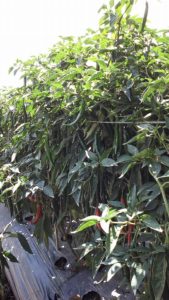A newly developed irrigation system known as drip irrigation or trickle irrigation, originally developed in Israel, is becoming popular in areas of water scarcity. In this irrigation system, a small amount of water is applied at frequent intervals in the form of water droplets through perforations in plastic pipes or through nozzles attached to tubes spread over the soil to irrigate a limited area around the plant.
A precise amount of water equal to the daily consumptive use or the depleted soil water needs to be applied. The soil water can be maintained at the field capacity during the crop growing period. Deep percolation losses can be completely prevented and the evaporation loss is also reduced.
The application of water and piping systems needs to be designed according to the type of crops, topography and weather conditions typical to the geographical area.
The basic equipment for drip irrigation consists of a water supply head, a main pipe, lateral pipes and drippers. The water flow in the pipe system is controlled with control valves and fertilizers can be applied at the water source. As water passes through the very small outlets of drippers, it is filtered before h is distributed in the pipe system.
Advantages/Pros/Benefits of Drip Irrigation System:
1. In this method, water directly reaches the roots of the plants, which take water to plants in balanced quantities.
2. Drip irrigation method saves 30 to 70 per cent water and it is possible to irrigate three times more area with the same amount of water.
3. In this method, weeds do not spread because water reaches only near plants and does not spread in the whole field.
4. Fertilizers and insecticides can also reach the plant directly by solution in the water and it saves 30 to 60 per cent chemical fertilizers as well as 40 to 50 per cent pesticides along with saving of water.
5. Even in case of uneven lands, drip irrigation method can do balanced irrigation.
6. Cultivation in saline and alkaline soil also can be done by this method of irrigation.
7. Crop production is higher by 20 to 40 per cent in drip irrigation method, because plants can get air and water in required quantities, resulting in regular growth of crops.
8. Lesser labourers are required for irrigation work.
9. Bacteria causing diseases in crops do not grow because of dry atmosphere near plants.

Disadvantages/Cons of Sprinkler Irrigation System:
1. Drip irrigation method is expensive.
2. It requires special technical knowledge for successful operation of this method.
3. In heavy soils, it creates problems of flow and water blockages.
4. Plants are able to get nutritive elements in a very limited area.
5. It is not suitable for every crop.
6. Utmost care has to be taken for holes of drippers, because soil may come along with water at any time, which will prevent water dripping smoothing from holes.
7. Animals may cause damage to branch pipelines and dripper pipelines.
8. Most of the drippers work on pressure. Wherever land is sloppy, pressure on valves increases by 50 to 10 per cent, which results in stoppage of working of valves on the upper side.
